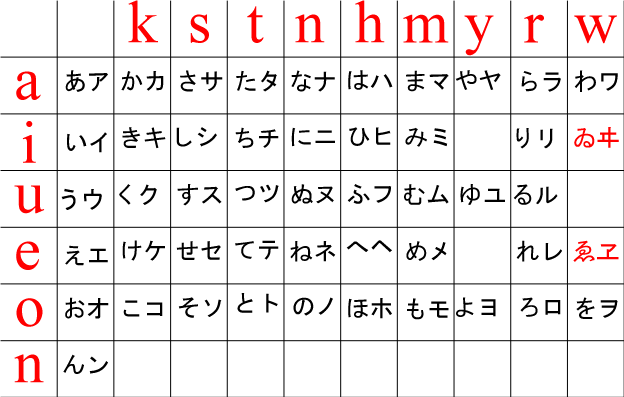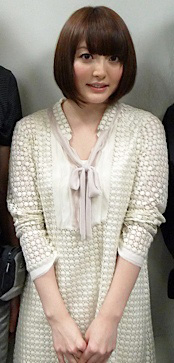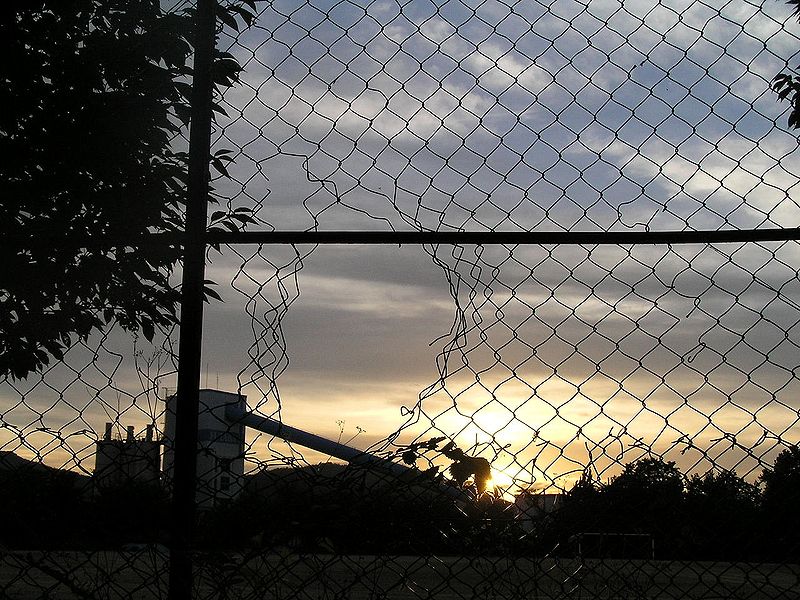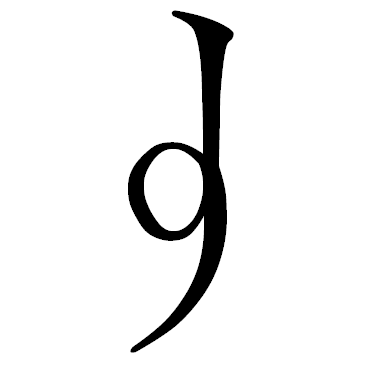Kana (ä»®å) are syllabic Japanese scripts, a part of the Japanese writing system contrasted with the logographic Chinese characters known in Japan as kanji (æ¼¢å—). There are three kana scripts: modern cursive hiragana (ã²ã‚‰ãŒãª), modern angular katakana (カタカナ), and the old syllabic use of kanji known as man’yÅgana (万è'‰ä»®å) that was ancestral to both. Hentaigana (変ä½"ä»®å, "variant kana") are historical variants of modern standard hiragana. In modern Japanese, hiragana and katakana have directly corresponding character sets (different sets of characters representing the same sounds).
Katakana with a few additions is also used to write Ainu. Kana was used in Taiwanese as a gloss (furigana) for Chinese characters during the Japanese administration of Taiwan. See Taiwanese kana.
Each kana character (syllabogram) corresponds to one sound in the Japanese language. This is always CV (consonant onset with vowel nucleus), such as ka, ki, etc., or V (vowel), such as a, i, etc., with the sole exception of the C grapheme for nasal codas usually romanised as n. This structure had some scholars label the system moraic instead of syllabic, because it requires the combination of two syllabograms to represent a CVC syllable with coda (i.e. CVn, CVm, CVng), a CVV syllable with complex nucleus (i.e. multiple or expressively long vowels), or a CCV syllable with complex onset (i.e. including a glide, CyV, CwV).
Hiragana and katakana

The following table reads, in gojūon order, as a, i, u, e, o (down first column), then ka, ki, ku, ke, ko (down second column), and so on. n appears on its own at the end. Asterisks mark unused combinations.
- There are no kana for ye or yi, as corresponding syllables do not occur in Japanese natively. While there was kana for wu, it usage ended much earlier due to that sound likewise never having existed in Japanese, and it does not yet exist in Unicode. The [je] sound is believed to have existed in pre-Classical Japanese, mostly prior to the advent of kana, and is generally represented for purposes of reconstruction by the kanji 江, although an archaic hiragana we/ye, ã‚', does exist. In later periods, the syllabogram we came to be realized as [jÉ›], as demonstrated by 17th century-era European sources, but it later merged with the vowel e and was eliminated from official orthography in 1946. In modern orthography, if necessary, [je] may be written as ã„㇠(イェ); however, this usage is limited and nonstandard.
- While no longer part of standard Japanese orthography, wi and we are sometimes used stylistically, as in ウヰスã‚ー for whisky and ヱãƒ"ス for Yebisu, a brand of beer. Hiragana wi and we are still used in certain Okinawan writing systems, while katakana wi and we are still used in Ainu.
- wo is preserved only in a single use, as a grammatical particle, normally written in hiragana.
- si, ti, tu, hu, wi and we are often transcribed into English as shi, chi, tsu, fu, i and e instead, according to contemporary pronunciation.
Diacritics
Syllables beginning with the voiced consonants [g], [z], [d] and [b] are spelled with kana from the corresponding unvoiced columns (k, s, t and h) and the voicing mark, dakuten. Syllables beginning with [p] are spelled with kana from the h column and the half-voicing mark, handakuten.
- zi, di, and du are often transcribed into English as ji, ji, and zu instead, respectively, according to contemporary pronunciation.
- Usually [va], [vi], [vu], [ve], [vo] are represented by ãƒ[ba], ãƒ"[bi], ブ[bu], ベ[be], ボ[bo] without making distinctions, but in rare cases each of them are represented by ヴァ, ヴィ, ヴ, ヴェ, ヴォ. Note: ヴ does not have the Hiragana form until JIS X 0213.
Digraphs
Syllables beginning with palatalized consonants are spelled with one of the seven consonantal kana from the i row followed by small ya, yu or yo. These digraphs are called yÅon.
- There are no digraphs for the semivowel y and w columns.
- The digraphs are usually transcribed with three letters, leaving out the i: CyV. For example, ãゃ is transcribed as kya.
- si+y* and ti+y* are often transcribed sh* and ch* instead of sy* and ty*. For example, ã—ゃ is transcribed as sha.
- In earlier Japanese, digraphs could also be formed with w-kana. Although obsolete in modern Japanese, the digraphs ãã‚Ž (/kwa/) and ãã‚/ãã†ãƒ(/kwi/), are still used in certain Okinawan orthographies. In addition, the kana ㈠can be used in Okinawan to form the digraph ãã‡, which represents the /kwe/ sound.
Modern usage

- See also: Japanese writing system, Hiragana, Katakana.
The difference in usage between hiragana and katakana is stylistic. Usually, hiragana is the default syllabary, and katakana is used in certain special cases.
Hiragana is used to write native Japanese words with no kanji representation (or whose kanji is thought obscure or difficult), as well as grammatical elements such as particles and inflections (okurigana).
Today katakana is most commonly used to write words of foreign origin that do not have kanji representations, as well as foreign personal and place names. Katakana is also used to represent onomatopoeia and interjections, emphasis, technical and scientific terms, transcriptions of the Sino-Japanese readings of kanji, and some corporate branding.
Kana can be written in small form above or next to lesser-known kanji in order to show pronunciation; this is called furigana. Furigana is used most widely in children's or learners' books. Literature for young children who do not yet know kanji may dispense with it altogether and instead use hiragana combined with spaces.
History

The first kana was a system called man'yÅgana, a set of kanji used for their phonetic values, much as Chinese uses characters for their phonetic values in foreign loanwords today. Man'yÅshÅ« (万è'‰é›†), a poetry anthology assembled in 759, is written in this early script. Hiragana developed as a distinct script from cursive man'yÅgana, whereas katakana developed from abbreviated parts of regular script man'yÅgana as a glossing system to add readings or explanations to Buddhist sutras. Hiragana was developed for speed, whereas katakana developed to be small.
Kana is traditionally said to have been invented by the Buddhist priest KÅ«kai in the 9th century. KÅ«kai certainly brought the Siddham script home on his return from China in 806; his interest in the sacred aspects of speech and writing led him to the conclusion that Japanese would be better represented by a phonetic alphabet than by the kanji which had been used up to that point. The modern arrangement of kana reflects that of Siddham, but the traditional iroha arrangement follows a poem which uses each kana once.
The present set of kana was codified in 1900, and rules for their usage in 1946.
Collation
Kana are the basis for collation in Japanese. They are taken in the order given by the gojÅ«on (゠ㄠㆠ㈠㊠… ã‚ ã‚' ã‚"), though iroha (ㄠ゠㯠㫠㻠㸠㨠… ã› ã™ (ã‚")) ordering is used for enumeration in some circumstances. Dictionaries differ in the sequence order for long/short vowel distinction, small tsu and diacritics. As Japanese does not use word spaces (except for as a tool for children), there can be no word-by-word collation; all collation is kana-by-kana.
Kana in Unicode

The hiragana range in Unicode is U+3040 ... U+309F, and the katakana range is U+30A0 ... U+30FF. The obsolete and rare characters (wi and we) also have their proper code points.
Code points U+3040, U+3097, and U+3098 are unassigned as of Unicode 6.3. Characters U+3095 and U+3096 are hiragana small ka and small ke, respectively. U+30F5 and U+30F6 are their katakana equivalents. Characters U+3099 and U+309A are combining dakuten and handakuten, which correspond to the spacing characters U+309B and U+309C. U+309D is the hiragana iteration mark, used to repeat a previous hiragana. U+309E is the voiced hiragana iteration mark, which stands in for the previous hiragana but with the consonant voiced (k becomes g, h becomes b, etc.). U+30FD and U+30FE are the katakana iteration marks. U+309F is a ligature of yori (より) sometimes used in vertical writing. U+30FF is a ligature of koto (コト), also found in vertical writing.
Additionally, there are halfwidth equivalents to the standard fullwidth katakana. These are encoded within the Halfwidth and Fullwidth Forms block (U+FF00â€"U+FFEF), starting at U+FF65 and ending at U+FF9F (characters U+FF61â€"U+FF64 are halfwidth punctuation marks):
There is also a small "Katakana Phonetic Extensions" range (U+31F0 ... U+31FF), which includes some extra characters for writing the Ainu language.
Unicode version 6.0 also includes "Katakana letter archaic E" (U+1B000) and "Hiragana letter archaic YE" (U+1B001) in the Kana Supplement block.
See also

- Gojūon
- Romaji
- Transliteration and Transcription
- Historical kana usage
- Man'yÅgana
- Hentaigana
References

External links

- KanaQ Kana flashcard tool that runs on mobile phones.
- Real Kana Practice hiragana and katakana using different typefaces.
- Origin of Hiragana
- Origin of Katakana
- Change Kanji into Romaji and Hiragana
- Kana web translator - Transliterate Kana to RÅmaji
- Kana Copybook (PDF)
- Kana no quiz Free/libre and cross-platform educational software to memorize Japanese kana pronouncing & transcription.
- KanaQuest Memorize Japanese words and kana with multiple quizzes.

Posting Komentar